Text
Group Design Challenge
On the 13th of October, the final method is putting together everything we’ve learnt in the last 11 weeks in the form of Integrative interdisciplinary Practices. My group and I’s task was to design a strategy we would use to create a future university and pitch it using any of all the methods we’ve used so far.
Our strategy was to utilize Systems thinking loops, sketches, and ideation methods and show them to the people we are pitching to. We wanted to create a university that doesn’t require attendance to campus.
The simple mind maps used for ideation allowed us to create problems and address them with different solutions and to see the different approaches we could take. We used a loopy diagram to show how this might work and how it can benefit the university and the students. Our simple sketches give a visual idea on how home learning can work, regarding VR and AR equipment.
Ideation:

Systems:

Drawing:
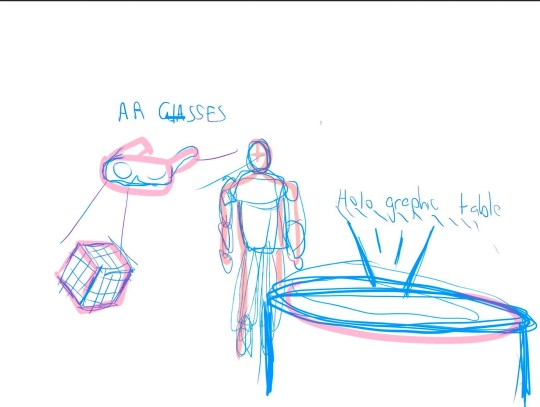
0 notes
Text
Systems Thinking
On the 6th of October, we had a look at systems thinking. From what I had taken away from it is that in a system, there’s a cycle that takes away from each component and also adds to each other, creating a delicate balance and flow. An analogy of this cycle is like lion kings, the circle of life, where the herbivores eat the foliage, the next in the food chain eat the herbivores, and when those next in the food chain pass on, their bodies fertilize the foliage that the herbivores eat and the cycle continues. We created this using wolves in the wild:

Our second system is using mouldy unhealthy homes as the main problem, and building a cycle around that with other problems and solutions.

To use systems thinking in my creative process, I could use a problem as my central theme and see how that problem affects a cycle. An example would be If I was creating a product to prevent E-Waste. I’d need to figure out an approach on creating this product without creating more E-Waste myself.
The ‘Ideation’ method can compliment ‘System Thinking,’ by placing the many ideas as components to use in the system and see whether it affects the cycle in a positive way.
Looking at the different ideas like recycled materials as a System component can create a cycle that can potentially decrease E waste if the system is simulated correctly.
0 notes
Text
User Centered Design
On the 29th of September, we went over design thinking with Vanessa Ceelan. The idea was to create as many ideas as fast as possible whether they’re good ideas or not so good ideas. It was also designing with empathy and for a purpose.
The process:
empathise - define - ideate - prototype - test
Here i have the sheet i was working on:

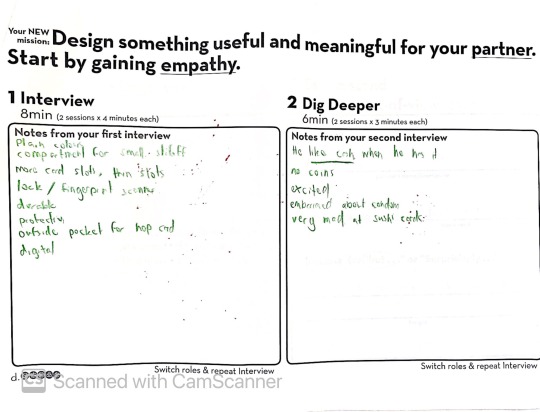

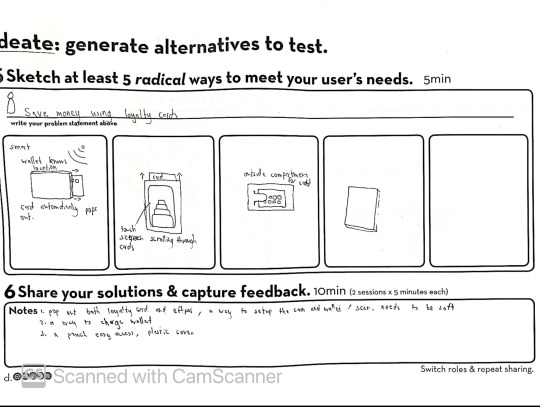


The final wallet design for lachie turned out to be a phone case wallet. It prevents the need to hold both your phone and wallet seperately, while also being slim and smart (has an app).

With this wallet, i asked my girlfriend what her thoughts are on it.
What does she like?
She likes that its one less thing to carry around and it’s slim.
What would she change?
She would add a little pouch for cash. Colours would also be nice to customise.
Her questions about it were: does it have a battery because it connects to your phone. What if the wallet runs out of battery.
Her ideas were: plug the wallet in through the bottom charging port on the phone, or use reverse wireless charging.
With that i remade the wallet, cleaner, and added a zipped pouch for cash at the bottom. The supposed material changed from a hard metal to a stretchy fabric or leather to allow space for cash. Using the idea of the phones reverse charging can be used to charge the wallet. The cash department is also handy for when all batteries are dead.
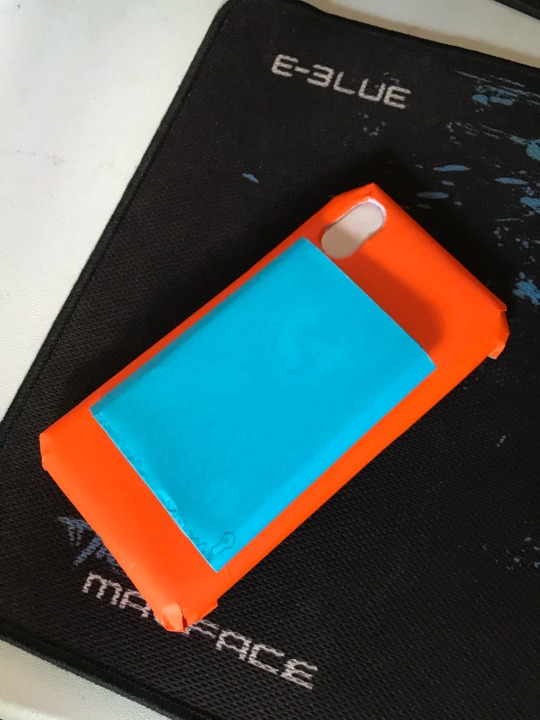


0 notes
Text
Sectional Drawing
On the 1st of September, we looked at drawing as a powerful tool to convey ideas and put our imagination onto paper. Sectional drawings are about cutting through an object and drawing the details between the cut such as:
- the vertical arrangement of spaces
- nature of the construction of the enclosure
- a relationship to the ground
- imagining of occupation and inhabitation.
My object was an onion as ‘onions have layers.’

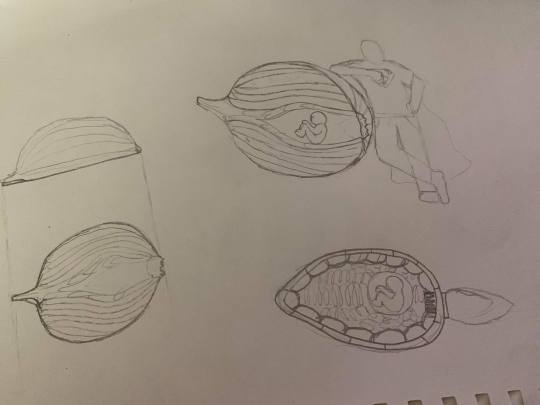
Drawing as a research method is very powerful for conveying your ideas in a visual manner. For ideas, I often sketch low quality outlines and shapes, and then later drawing a more finalised outcome with a darker pencil. I also like to put things to scale, or adjusting to convey the idea as clear as possible.
I use drawings in a form of iconography. Removing words, and using images is a powerful tool I use to gain the attention and interest of the viewer. Images and icons is it’s own language that can be understood by people all around the world.
0 notes
Text
Ideation
On the 25th of August, we were looking at ideation using design methods. Here i am using the Lotus diagram to plot down ideas i have for my studio project.
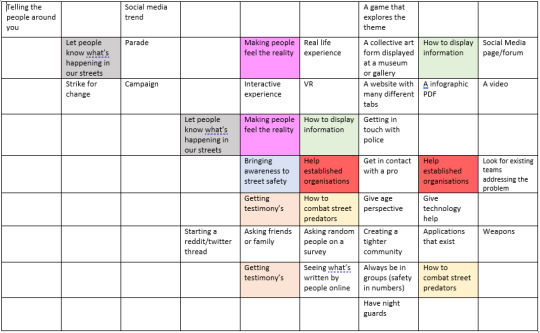
Using thinking hats to refine 3 of the ideas from the lotus diagram:

This exercise slightly helped me with my creative thinking as it targets an idea from all angles, and asks questions on why it might be a good or bad idea, or what can be improved. It also reminds me that being creative is something that you have to put a lot of thought into.
I won’t be using the model of lotus diagrams, or the thinking hats, as it’s confusing and feels more like a forced checklist than a creative process. Instead I’ll take its concept and use the infinite ‘Why?’ after every outcome to target the different angles of my idea generation.
0 notes
Text
Lo-Fi Prototyping
On the 18th of August we explored the importance of Lo-Fi prototyping in the creative process. This is about making models quickly with low cost materials. Fort Ln. is the area we were prototyping for.
My idea is definitely an outdoor cover to prevent people who are standing outside from getting wet. It’s designed more for practicality as it’s still made of glass and metal bars for light to pass through. The arrow design is more of an art installation, basically re-informing the people there that it is a one way street.
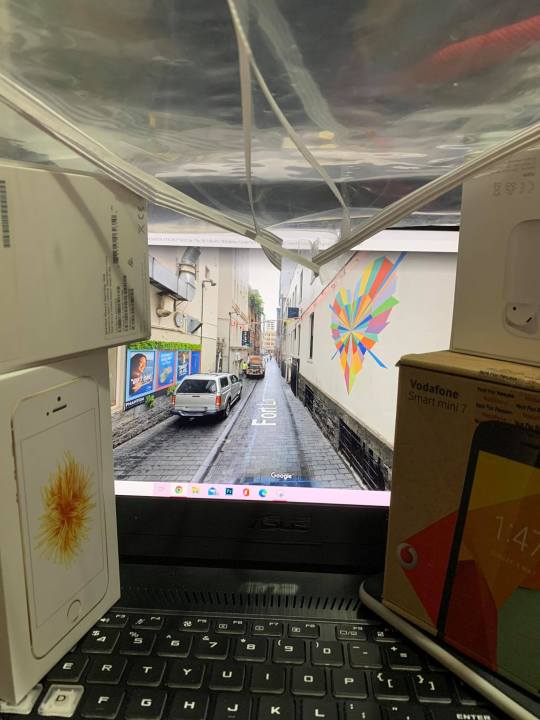
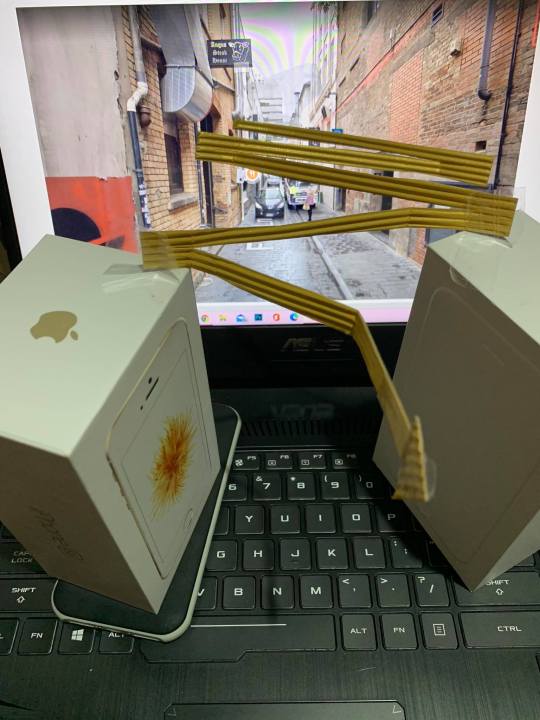
Engaging with a physical 3D prototype helps me better understand the sense of scale, along with figuring out how my design can fit and be attached onto the surrounding buildings. It also allows the design to viewed from different perspectives when compared to a 2D plane.
0 notes
Text
Material Interrogations
On the 11th of August, Clint introduced us to the practice of Material Interrogations.
My object is a Playstation 1 controller. It’s significant to me because the first access I had to videogames was on the playstation. It was a digital toy to me as a kid, and so it has since kindled my love for technology, games and media.
I started out by recording the sound of the controller when the buttons and joysticks are interacted with.
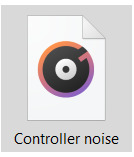
I then converted the recorded file that was an .m4a to an .mp3.
Using Audacity, I used the Paulstretch effect on the audio at its default setting 3x before exporting.


I then opened the mp3 into a notepad file, took a screenshot and pasted it into photoshop.

In photoshop I used the liquify filter, clicking on random points of the screenshot. I then auto liquified 3x. I then used messed with the saturation and darkness of the image and then exported it as a png.

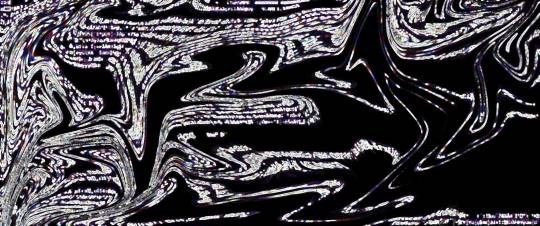
With the .png and the .mp3, I merged them together in a video using the video editor application, and the outcome was a video with an eary noise and confusing visuals.
With this method, I learned that you can turn one simple object into many different forms. Although some outputs don’t always work, it’s fun experiencing outputs that do. It allows awesome outcomes. For future projects, this can become useful for transforming an idea that doesn’t work into something else completely.
0 notes
Text
Soundwalks and SoundScaping
On the 4th of August, my carbon group went to Albert Park, Sky world entertainment centre and Aotea Centre listing, and describing all the sounds we can hear. This method is called SoundWalks and SoundScaping.

Albert Park: At the park you can hear the peaceful wind brushing through the blades of grass. You can hear people laugh, birds tweet, shoes scraping the ground. There was no loud noises. There was a very strong white noise coming from the city streets. The bells went DING-DONG and can be heard from afar.
Through the use of surround sounds speakers, placed in trees, in bins, or on structures, adding nice rain sounds hitting a roof, or a nice loud breeze sound on a sunny day while lying under a tree can help relax people, making the area more pleasant.
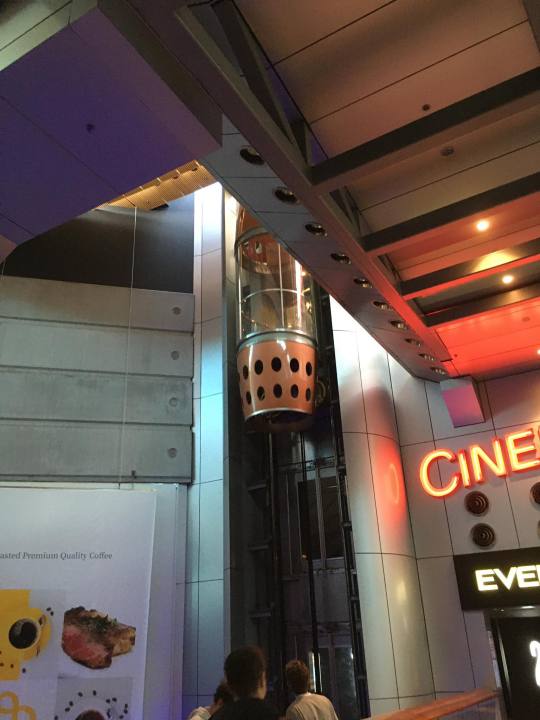
Sky World: PEW PEW, DING DING, you can hear the arcade machines in use. There was a lot of electric buzzing from the neon signs, air vents having a hollow noise, peoples shoes squeaking on the glossy ground along with mall music.
Through the use of noise cancelling foam, we can get rid of the echoes that are created due to the large hollow space. This can get rid of that eary, cold feeling of being in a large space, making the place sound more pleasant.
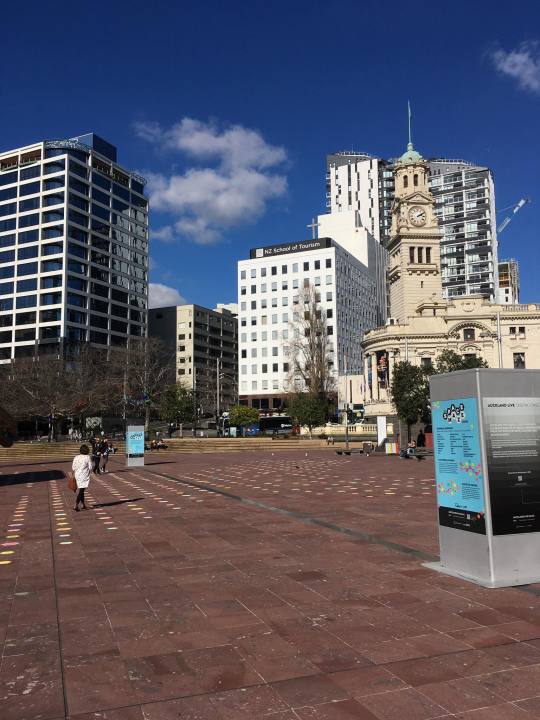
Aotea Centre: Main thing that was heard here was the constant construction noise happing. You can constantly hear the drills and saws going EEEEEE, and the BANGing of the hammers. There was also an exhibition of some sort showcasing a humanoid robot making weird noises like burps.
Through the use of sound cancellation technology, I would like to dampen the construction noise to lessen the chaotic sounds in a peaceful area. This will make the area more pleasant for people to visit and pass through while also helping those around the area from the loud noises.
0 notes
Text
Cultural Probes as a research method
On the 28th of July, we used cultural probes as a way of gathering information. In a group of 5 we had to create cultural probes using paper, card and pencils to gather information on how drones can help the everyday lives of farmers. My team and I created a mini mock-up disposable camera that prints Polaroids, a board to place the photos on, and 2 large envelopes to send and receive the data.
Cultural probes can also be used by teachers on pre-school kids that don’t know how to read or write yet. They can be handed little packages with letters, numbers, shapes, colours and animals which can trigger their excitement and fondness to learn.
The ways this method can fail is by not having the user sending it back or not completing the activities. Another is that because it’s not as straight forwards as asking the participants questions, it can be time consuming, costs more and can be a hassle for both the receiver.

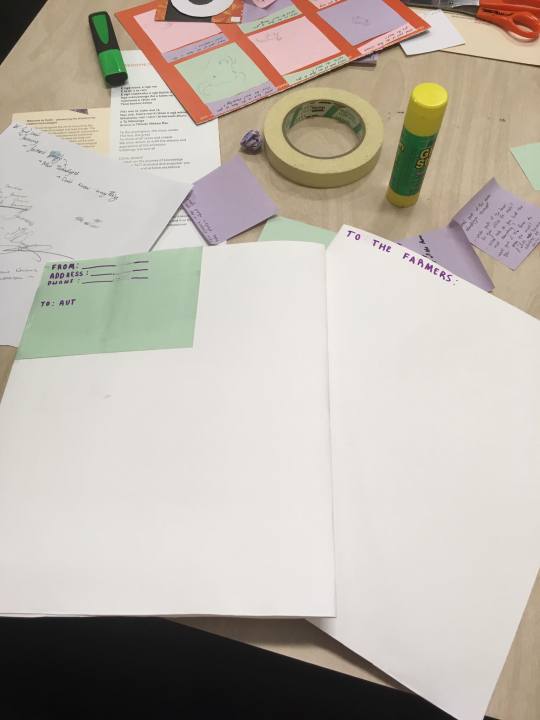
0 notes
Text
Walking as a research method
On the 21st of July, first year Creative Tech and Architecture students came together for integrative practices. The first method is walking. With an unplanned journey, my group walked around AUT, and as we walked our goal was to look for things that are out of place and draw them with a 1 minute limit which is not a lot. We were also challenged with instructions like not lifting the pen off the page, or trying to draw as precisely as we can, or even writing down notes instead of drawing.
This exercise helped me appreciate finer details in our environment as I looked around. Observing everything around me, there was a lot of little details that were “out of place.” I noticed little statues on the windowsill that I’ve never seen before. Every step provides a new P.O.V.
For future projects I can use walking around and surveying our surroundings, to help point out new things in our environment or people which can be used as research and information. Walking also releases endorphins which can clear our minds and help us think more clearly.
Images:
1. Fence with a pipe and rubbish
2. Mini statues on windowsill
3. Fallen Branch
4. Wall with unintentional paint splatters
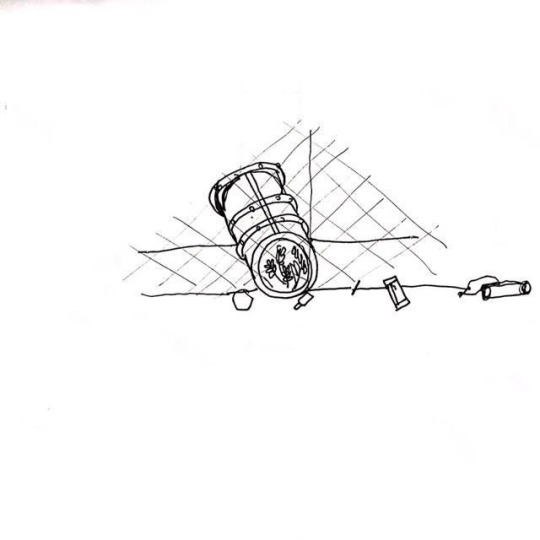


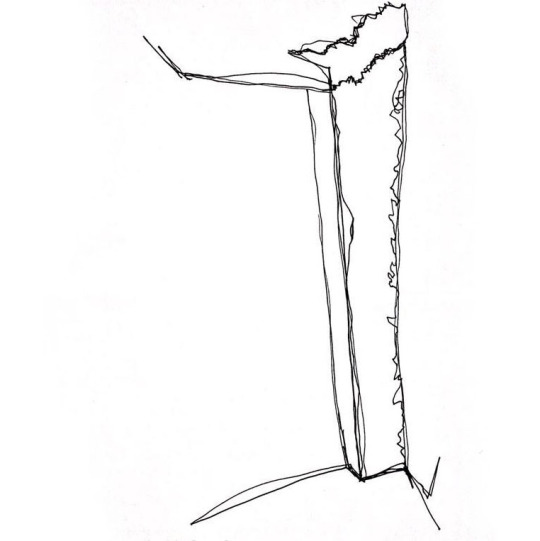
After choosing 1 of the 5 drawings, here is how my ‘Carbon’ group decided to curate our drawings. There were 2 rules, we overlapped our papers trying to reduce white space, while also not leaving any gaps between the pages. We then later found out that it was a bit hard as the rectangular paper was awkward with orientation and placement.
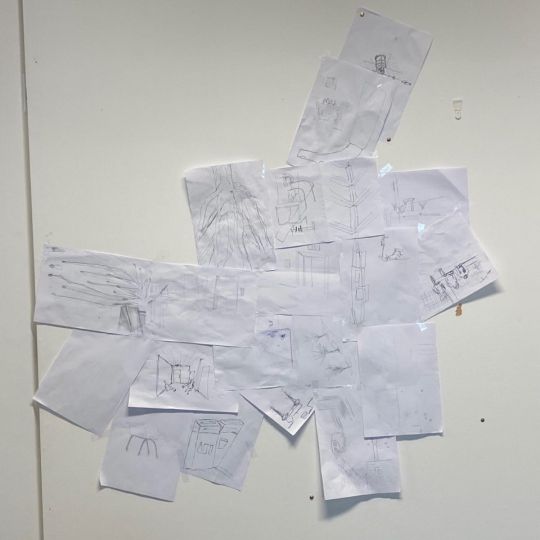
0 notes